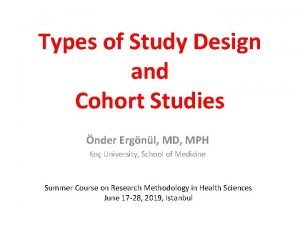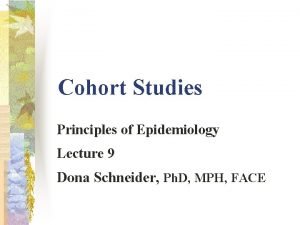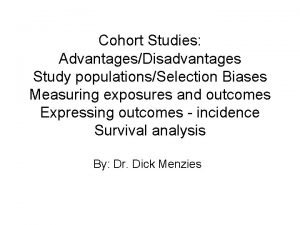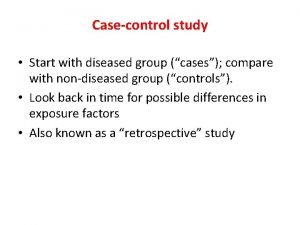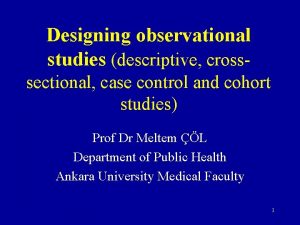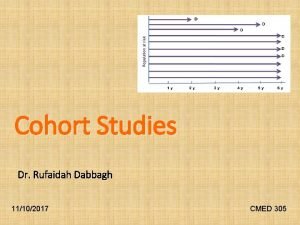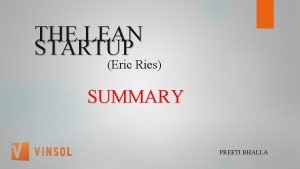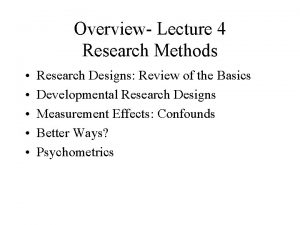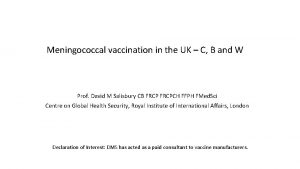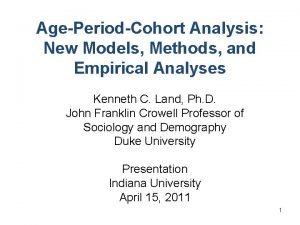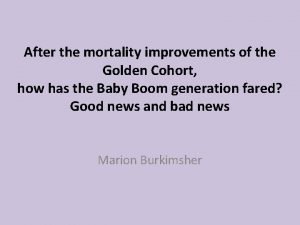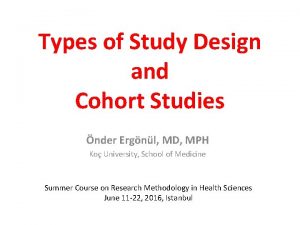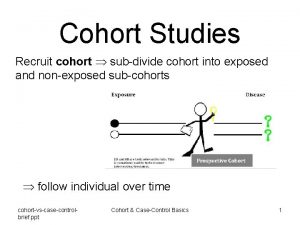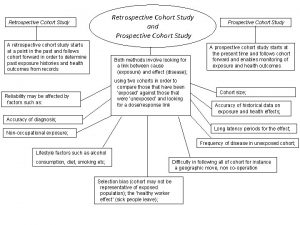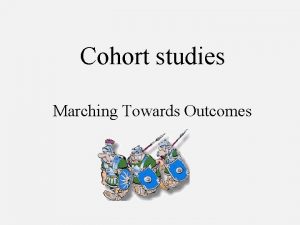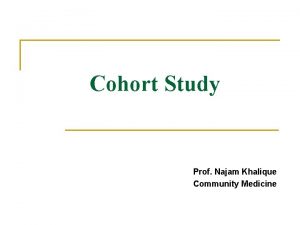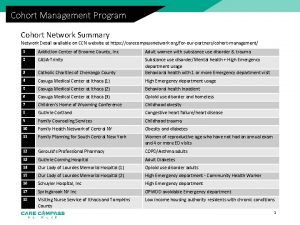Types of Study Design and Cohort Studies nder











































- Slides: 43

Types of Study Design and Cohort Studies Önder Ergönül, MD, MPH Koç University, School of Medicine Summer Course on Research Methodology in Health Sciences June 17 -28, 2019, Istanbul

How to evaluate studies? 1. Validity of the results (Internal validity) – Is the design appopriate? – Is bias controlled? – Is the statistical analysis correct? 2. Precision of the results – Is the effect relevant and precise? 3. Generalizibility (External validity) – Does it apply to my patients?

The Stages of Study 1. 2. 3. 4. 5. 6. Background Hypothesis Design Data collection Analysis Report

RCT or Meta-analysis Non randomized but controlled Multicentric cohort or case control Expert opinion, descriptive, case series

Study Designs Does investigator decide for exposure? YES NO Experimental (interventional) Observational (non interventional) Randomization? Comparison Group YES RCT NO Non-randomized Controlled YES Analytical NO Descriptive

Study Designs exposure COHORT outcome exposure Case-control outcome Cross sectional Exposure Outcome

Cohort Studies Roman cohort

Early Cohort Studies • • Farr John Snow Golderberger Frost 1835 : On Prognosis, Lancet 1854 1935 (case control/intervention) 1933

Cholera vs Tuberculosis “Phthisis is more dangerous than cholera; but cholera, probably excites the greatest terror” “Cholera destroys in a week more than phthsis consumes in a year” William Farr, 1935

Prospective Cohort Studies 34, 000 male British doctors 190, 000 male and female American citizens with different smoking habits Framingham 5, 000 middle aged residents of Framingham with different blood pressures, blood cholesterol levels, etc. 1946 Birth Cohort 13, 000 children born in the UK in one week in 1946 with different family backgrounds.

The History of Cohort Studies; Tuberculosis in generations The term "cohort study" was introduced by Frost in 1935 He aimed to describe the disease experience of people born at different periods, in particular the sex and age specific incidence of tuberculosis.

“Generation” or “Generation Cohort” Studies Such studies were described as generation studies or generation cohort studies to distinguish them from the common descriptive studies. Initially called prospective studies, because the information characterising the individuals in the cohorts was recorded before the onset of disease, they are now preferably called cohort studies and distinguished as prospective cohort studies.

Mortality from Tuberculosis, Frost, 1935 Age Specific Mortality versus Generation Cohort Frost WH. The age selection of mortality from tuberculosis in successive decades. Am J Hyg 1939; 30: 91 -6. Doll R, 2001

Lung Cancer Epidemics, Korteweg, 1952, Netherlands Korteweg R. The age curve in lung cancer. Br J Cancer 1952; 5: 21 -7

More doctors smoke camels than any other cigarette! 113, 597 doctors were asked 1946, USA http: //www. youtube. com/watch? v=g. CMzj. Jjux. QI

Smoking is Fatal: British doctors study • Doctors: high response rate 40000/60000 • 1951 • One page, 7 questions Why 7 questions? (An investigator should ask 5 times before including one question) • 10 year follow up

British doctors study

Framingham Heart Study 18

https: //www. youtube. com/watch? v=HZp. Yk. D_pl Pw

1960 s: The Cohort Study Definition 10 years after Korteweg’s paper, the term cohort study began to be given the much wider meaning that it now has: “any study in which groups of people with defined characteristics are followed up to determine in incidence of, or mortality from, some specific disease, all causes of death, or some other outcome. ”

Exposure and outcome exposure NO exposure

Incidence rate = incidence density A / time CI = Number of new cases of a disease during a given period of time Total person time of observation Jan Feb March April May June Total Time at risk A 3 months B 6 months C 2 months Total person time 3+6+2=11

Alzheimer infection a No Alzheimer b Study group Alzheimer No infection c No Alzheimer d

Relative Risk for Cohort Design No Schizophrenia CNS infection in childhood No CNS infection a c b d RR= a / (a+b) : c / (c+d)

The Confidence Interval for the Effect Size

Retrospective Cohort Sonuç (outcome) exposed Sonuç yok Study group Sonuç yok Etkene maruz kalmayanlar (kontrol) Araştırmanın yönü zaman Onset of study

Retrospective Cohort Studies 1. 2. 3. 4. Spread of tuberculosis in families, Frost, 1933 Nickel refiners’ study, Hill, 1966 Gas workers’ study, Doll, 1952 Life span study of the atomic bomb survivors, Atomic Bomb Causalty Commission, 1956 5. Ankylosing spondylitis study, 1957

Cohort Effect • Certain illnesses may be socially affected and cohort effects can be an indicator of this sort of phenomenon. • Cohorts in organizations are often defined by entry or birth date, and retain some common characteristic (size, cohesiveness, competition) that can affect the organization. For example, cohort effects are critical issues in school enrollment. • In medical literature, cohort effect should be known to detect and/or avoid selection bias. • Birth cohort effect in LTBI in US (BMC Infect Dis 2010)

Biases in Cohort Studies 1. Bias in assessment of the outcome 2. Information bias 1. Particularly in historical control 3. Biases from non-response and losses to follow up 4. Analytic bias

Cross-over study design With outcome Experimental subjects Subjects meeting entry criteria Without outcome With outcome Controls Without outcome Onset of study With outcome Experimental subjects Intervention Without outcome Washout period Intervention Time 30

Factorial design A factorial design is used to evaluate two or more factors simultaneously. The advantages; answer 2 or more questions in a single trial for only a marginal increase in cost.

Factorial Design: The Physician’s Health Study randomized Aspirin placebo aspirin Beta carotene placebo

Randomized Clinical Trials Avoid the biases 1. Misclassification 2. Management of the confounders

Randomized controlled trial design Experimental subjects With outcome Without outcome Subjects meeting entry criteria With outcome Controls Without outcome Time Onset of study Intervention 34


Randomization • First randomizasyon: Fisher, 1923 – Objective: The efficacy of different fertilizers Old method: compare different fields New method: 1. Divide the field into small pieces 2. Apply the fertilizers randomly

Randomized Clinical Trials Randomization is not enough! • Intention to Treat (ITT) • Per Protocol (PP)

Intention to Treat Analysis • After randomization, – The patients who did not receive treatment – Deviations from protocol – Include all the patients Fisher LD, et al. Intention to treat in clinical trials. In: Pearce KE, ed. Statistical issues in drug research and development. New York: Marcel Dekker, 1990: 331 -350

Why ITT needed? Since 1990 s. Fisher LD, et al. Intention to treat in clinical trials. In: Pearce KE, ed. Statistical issues in drug research and development. New York: Marcel Dekker, 1990: 331350 1. Check the similarities and differences of treatment and control arms. 2. Management of non-compliance and deviations

ITT is more realistic, PP is falsely optimistic

What if ITT not performed? • If not performed, the efficacy could be found much better than expected (extremely optimistic) • Good for practical purposes, not for biologic explanation. • Possible if all the outcomes of randomized subjects are available.

Flow Diagram Design Analysis Reading

“Make everything as simple as possible, but not simpler”
 Retrospective cohort study
Retrospective cohort study Study design types
Study design types Types of cohort studies
Types of cohort studies What is case series
What is case series Bias in cohort studies
Bias in cohort studies Longitudinal prospective study
Longitudinal prospective study Case control study example
Case control study example Cohort study example
Cohort study example Retrospective cohort study vs case control
Retrospective cohort study vs case control Experimental research design types
Experimental research design types Retrospective cohort study
Retrospective cohort study Cohort study community medicine
Cohort study community medicine Cohort study meaning
Cohort study meaning Outdoor education study design
Outdoor education study design Bundesl@nder deutschland
Bundesl@nder deutschland Matematika
Matematika Bundesl#nder deutschland
Bundesl#nder deutschland Bundesl#nder deutschland
Bundesl#nder deutschland Legal studies study design 2021
Legal studies study design 2021 Elements of theatre composition
Elements of theatre composition What is visitor pre registration in picme
What is visitor pre registration in picme Paradigm shift from women studies to gender studies
Paradigm shift from women studies to gender studies Cohort event monitoring
Cohort event monitoring Cratily
Cratily Retrospective cohort vs case series
Retrospective cohort vs case series Jinyun yan
Jinyun yan Cohort analysis lean startup
Cohort analysis lean startup Demographic cohort
Demographic cohort Cohort effects definition
Cohort effects definition Cohort model
Cohort model Cohort effects definition
Cohort effects definition Cohort effects definition
Cohort effects definition Golden cohort
Golden cohort Cohort event monitoring
Cohort event monitoring Students cohort
Students cohort Cohort adalah
Cohort adalah Cohort based courses
Cohort based courses Icarus first cohort
Icarus first cohort Kritik jurnal
Kritik jurnal Vcaa visual communication
Vcaa visual communication Types of research design
Types of research design What is method study
What is method study Objectives of work study
Objectives of work study Differentiate between time study and motion study
Differentiate between time study and motion study

